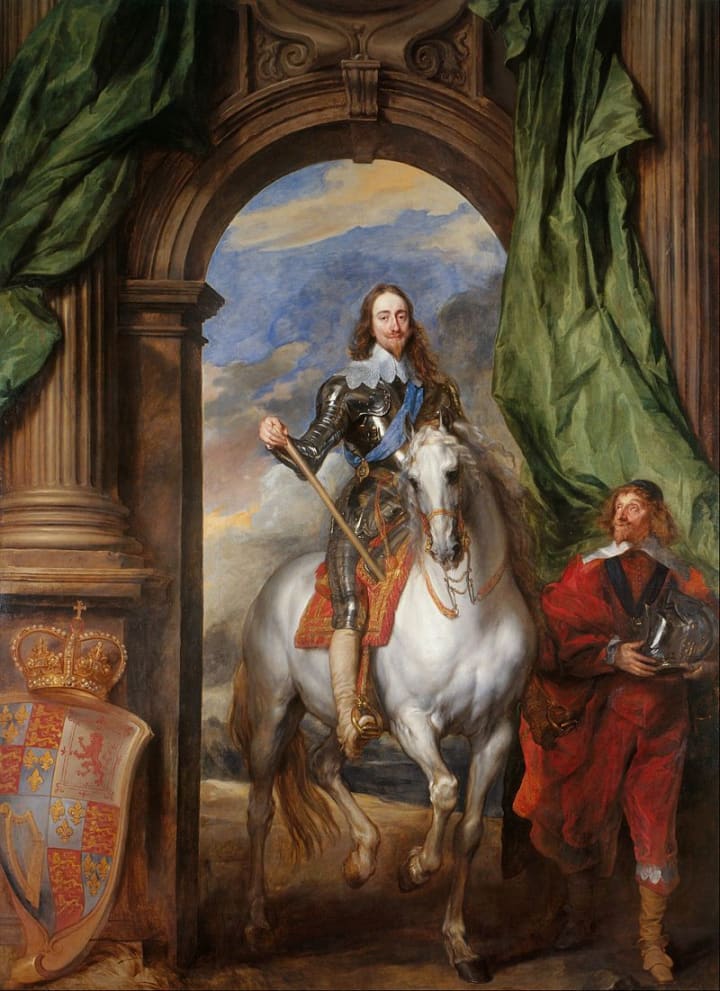King Charles I
"Never make a defense or apology before you are accused"

We know Charles I as the King who lost his head (literally), but I wonder how many of us know his life story. What sort of a man was he? How was he raised? Why didn’t he give into Parliament to save his own head? It is true to say, we will never have another King like Charles I!
Charles was born in Dunfermline Palace, Fife, on 19th November, 1600, the second son to King James VI of Scotland and Anne of Denmark. James was the first cousin twice removed of Queen Elizabeth I of England, and when Elizabeth died childless in 1603, he became the King of England, James I. When James and the Royal family left for England in 1603, when he became the King of England, Charles had to be left in Scotland because he was a weak, fragile and sickly infant. Lord Fyvie (a friend of his father) was appointed as Charles’s guardian. When he was three and a half years of age and able to walk ‘without assistance’, Charles made the journey to England to be with his family. When he arrived in England, Charles was placed under the charge of Elizabeth, Lady Carey (the wife of courtier Sir Robert Carey). She put Charles in Spanish leather and brass boots to strengthen his weak ankles. Having a stammer made speech development slow.
Even at such a young age, Charles was created the Duke of York and was made a Knight of the Bath. A Presbyterian Scot, Thomas Murray, was appointed as Charles’s tutor, who taught his young pupil the classics, languages, mathematics and religion. In 1611, Charles was made a Knight of the Garter. This young Prince managed to conquer his physical infirmities (which may have been caused by rickets), and eventually became an adept horseman and marksman, even taking up fencing. Charles adored his older brother, Henry Frederick (Prince of Wales) who was much taller and stronger. However, at eighteen years of age, Henry died (in 1612) of possibly typhoid. Charles, who had turned twelve a few weeks later, was now the heir apparent and was given several titles, including Duke of Cornwall and Duke of Rothesay. In 1616, Charles was now created the Prince of Wales and Earl of Chester.
The struggle between Catholics and Protestants continued to ‘rage’ through Europe, so James (Charles’s father) began to seek a marriage between Charles and the Catholic Princess Maria Anna of Spain, thinking that this was a possible ‘diplomatic means of achieving peace in Europe.’ The English Parliament was hostile towards this match and looked for a Protestant match for Charles. Now came the ‘fight’ between James I and Parliament, who insisted that the House of Commons should be concerned only with domestic affairs whilst members protested for their freedom of speech. Charles sided with his father, considering the discussion of his marriage within the Commons ‘impertinent.’ In January, 1622, James I dissolved Parliament, angry at the impudence and intransigence of its members.
Charles became friends with Buckingham, who was a favourite of his father, and in time, Buckingham began to have great influence over Prince Charles. When the two went to Spain, incognito, in 1623, to “woo” Charles’s bride, it was a disaster! The Spanish demanded that Charles convert to Roman Catholicism and the bride thought Charles to be little more than an infidel. On returning to London without his bride, Charles and Buckingham pushed James I to declare war on Spain. James summoned Parliament in 1624 to request subsidies for a war. The under-funded ‘makeshift’ army failed to advance beyond the Dutch coast. James was now ill and found it difficult to control Parliament. When he died in 1625, Charles and Buckingham had already assumed ‘de facto’ (acting with power even though Charles was not yet King).

Charles (and Buckingham) now turned their attention towards France for a marriage match, and Charles was married by proxy on 1st May, 1625. His bride was fifteen year old Henrietta Maria, a French Princess and a Roman Catholice. Many in Parliament were opposed to this marriage and the ‘war of religion’ continued in England. When Charles was crowned at Westminster Abbey on 2nd February, 1626, his wife was not at his side because Henrietta Maria refused to participate in a Protestant religious ceremony. Not a good start to the reign of Charles I!
King Charles I was the second Stuart King of Great Britain. As a man, Charles was reserved (his stammer stayed with him for all of his life), self-righteous and he had a high concept of Royal authority. Charles believed in the “Divine Right of Kings”, which was a political doctrine in defense of monarchical absolutism, which asserted that Kings derived their authority from God and could not be held accountable for their actions by any earthly authority such as Parliament. This King was a good linguist and “a sensitive man of refined tastes.” He spent a lot of money on the arts, being fond of Van Dyck and Rubens, and buying a great collection of paintings by Raphael and Titian (which was later dispersed under Cromwell). Charles also instituted the post of Master of the Kings Music, which involved supervision of the King’s large band of musicians (the post still survives today). All of this increased the Crown’s debts, which led to a crippling lack of money.
King Charles I was also deeply religious, favouring the high Anglican form of worship with all the ritual, but this was in contrast to his people, especially in Scotland, who preferred a plainer form of worship. As a result, Charles found himself ever more in disagreement on religious and financial ‘matters’ with many of the leading citizens of the time. Marrying a Roman Catholic Princess only made matters worse. Also, he had inherited disagreements with Parliament from his father, but Charles’s own ‘actions’ (especially in the ill-fated wars with France and Spain) brought about the crisis in 1628-1629. The “favourite” of both Charles and his father was greatly disliked, and the Duke of Buckingham was impeached by Parliament and murdered by a fanatic. Charles had now lost his ‘best friend.’
Showing how much he disliked being questioned as a King, Charles had his chief opponent (in Parliament), Sir John Eliot, put into prison within the Tower of London until his death in 1632. Further tension between Charles I and Parliament was centred around finances, which was made worse by the costs of war abroad and the growing religious suspicions at home. At a time when plots against Elizabeth I and the Gunpowder Plot during his father’s reign were still so fresh in the minds of the people, Charles’s marriage was ‘seen as ominous’ --- the people and Parliament were finding it hard to trust their King, Charles I.
The quarrels between Charles and his young wife, Henrietta Maria, did not help. There were disputes over her ‘jointure’, the appointments to her household and the way she practiced religion as a Catholic. Charles expelled the vast majority of her French attendants in August 1626. However, the relationship between the King and his wife improved after the death of the Duke of Buckingham. Henrietta Maria became pregnant for the first time and together, they started to embody the image of virtue and family life, and Court life became a model of formality and morality.
However, Charles dismissed his 4th Parliament in March, 1929, and decided to ‘go alone’, doing without Parliament’s advice or the taxes which only Parliament could legally grant. Another mistake Charles made was having advisors which were disliked, such as William Land the Archbishop of Canterbury and the Earl of Strafford, even though they were efficient. Gaining funds without Parliament made Charles’s reign even more unpopular, as he exploited the forest laws and used forced loans. King Charles' reign was going badly, and when he returned to Scotland for his Scottish Coronation in 1633, a rebellion started. The problem, again, was over religion. Charles attempted to impose a High Church liturgy and prayer book in Scotland which caused the riot in 1637 in Edinburgh. The King now felt he had to recall Parliament, but the “Short Parliament of April, 1640,” questioned Charles’s request for funds for a war against Scotland and was thus dissolved within weeks. Another Parliament was called in November of the same year, and this was called the “Long Parliament.” Over the next few years, “bills” went back and forth, and Charles had to agree that Parliament could no longer be dissolved without its own consent. Laud and Strattford were executed, and Parliament abolished the King’s Council. Even though Charles I still believed in the “Divine Right of Kings”, Parliament came back with a vengeance.
On 22nd August, 1642, Charles raised the Royal Standard calling for loyal subjects to support him. The Civil War began in England! In May, 1646, Charles placed himself in the hands of the Scottish Army who promptly handed the King over to the English Parliament. Showing, perhaps, his arrogance, Charles told the Parliamentary commanders: “You cannot be without me: you will fall to ruin if I do not sustain you.” Charles I truly believed in the “Divine Right of Kings.”

Escaping from Hampton Court in 1647 led to the 2nd Civil War of 1648, which ended when Cromwell took the victory at Preston in August. Now, King Charles I was put on trial.
The charge was high treason against the realm of England. Charles refused to plead, saying that he did not recognize the legality of the High Court (how dare they question a King ordained by God!). “The idea of trying a King was a novel one.” The Army had concluded that peace could only come to England if Charles I was put on trial and executed --- as long as Charles lived there would be no peace (or so they thought). In his own defense, the King said: “I would know by what power I am called hither --- I would know by what authority, I mean lawful; Remember, I am your King, your lawful King, and what sins you bring upon your heads, and the judgment of God upon this land. Think well upon it, I say, think well upon it, before you go further from one sin to a greater --- I have a trust committed to me by God, by old and lawful descent, I will not betray it, to answer a new unlawful authority.”
“I do stand more for the liberty of my people --- I am sworn to keep the peace, by that duty I owe God and my country; and I will do it to the last breath of my body.” Quite a statement made by King Charles I!

On 26th January, 1649, King Charles I was condemned to death and 59 of the commissioners signed the death warrant. On 30th January, 1649, Charles put his head on the block and was beheaded with one stroke. He was buried in private on 9th February, 1649, in the Henry VIII vault, In St.George's Chapel, Windsor Castle. Charles’s head had been sewn back onto his body, which was then embalmed and put into a lead coffin.
Having been brought up by James I, who himself believed in the “Divine Right of Kings”, it is not surprising that King Charles I actually believed that he was ‘ordained by God.’ I personally think that he cared for his people but was, perhaps, misguided in his actions. A sensitive man, interested in the “Arts”, Charles did bring some amazing pieces of artwork to England. It just seems a shame that Charles I is known for ‘being the King who had his head chopped off” rather than any good works that he actually did during his lifetime.
(Research: Wikipedia and The Royal Family)
About the Creator
Ruth Elizabeth Stiff
I love all things Earthy and Self-Help
History is one of my favourite subjects and I love to write short fiction
Research is so interesting for me too






Comments
There are no comments for this story
Be the first to respond and start the conversation.